FILE - This photo made available by NASA shows Hurricane Harvey over Texas on Saturday, Aug. 26, 2017, seen from the International Space Station. Experts say a combination of unusual factors turned Harvey into a deadly monster. The storm intensified just before it hit land, parked itself over one unfortunate area and dumped a record amount of rain. (Randy Bresnik/NASA via AP)
The Associated Press
WASHINGTON (AP) - The slow-moving, super-wet and especially devastating storm named Harvey is finally fizzling.
Since first hitting shore near Corpus Christi, Texas, more than a week ago, the storm dumped 27 trillion gallons of rain on Texas and Louisiana - enough to cover all of Manhattan a mile (1.6 kilometers) deep. It set a record for rainfall from a tropical system in the continental U.S., dropping 51.88 inches (1.3 meters) just outside Houston. That's only an eighth of an inch (3.2 millimeters) behind the U.S. record set in Hawaii in 1950.
The deluge damaged an estimated 156,000 dwellings, and parts of Houston may be flooded for another month. The death toll of 44 ranks it as the mainland's sixth deadliest hurricane in 50 years.
What made it so bad? Harvey was strange - in how it nearly dissolved once but roared back as a major hurricane, in how it intensified so quickly before hitting land, in how it parked itself over one unfortunate region for so long and, of course, in the amount of rain it generated.
"It had several unique characteristics in terms of its strength and track. And unfortunately they combined to produce a severe impact over a highly populated area," National Hurricane Center Acting Director Ed Rappaport said.
Harvey was born in the Atlantic southeast of Puerto Rico on Aug. 17, then got downgraded to a tropical wave and breezed into Mexico's Yucatan peninsula with little fanfare. But once Harvey got into the Gulf of Mexico on Aug. 23, it rapidly exploded into a Category 4 hurricane just a few hours before coming ashore, something experts had not seen happen much before.
It was the first Category 4 storm to make landfall in the United States since 2004. Rappaport and others said it will likely rank among the costliest storms to hit the United States. In some ways, it landed in the perfect place to wreak the most havoc. The worst of its rains stayed to the east of its eye and hit very close to the nation's fourth-largest city, a city that is as flat as a tabletop and especially prone to flooding.
That's what Harvey will be remembered for, even though coastal cities like Rockport were all but flattened, said University of Miami senior hurricane researcher Brian McNoldy. "They're going to take backstage to Houston."
Most hurricanes, including 2005's Katrina, weaken just before they hit shore. Harvey got much stronger, fueled in part by pockets of extra warm water in the Gulf of Mexico.
"Harvey was the first to go from tropical storm strength to major hurricane strength in its last 36 hours before U.S. landfall," Rappaport said.
Then it just stuck around.
For more than 130 hours - from 10 a.m. Friday, Aug. 25, through 10 p.m. Wednesday, Aug. 30 - Harvey was raining over some part of eastern Texas. When Harvey did move, including a dip back into the Gulf of Mexico for about a day, it was still close enough to drench Texas.
"It's extremely rare to have a major hurricane that just sits there after it makes landfall," McNoldy said.
Usually strong storms blast through an area, dump a foot or so of rain, and move on. But Harvey was stuck between two high pressure weather systems to the east and west that kept pushing it in opposite directions, so it just staggered in a zig-zag pattern across southeast Texas.
"The sheer area that was inundated by 20 inches (51 centimeters) of rain was unbelievable," said Jeff Masters, meteorology director of the private forecasting service Weather Underground.
If it had only continued a bit farther, over northern Texas, Harvey would not have been as wet. But by stalling near the coast, the storm was allowed to draw more and more moisture from the gulf and sustain extraordinary rainfall rates, including more than 4 inches (10 centimeters) per hour over the Beaumont-Port Arthur area, Masters said.
Finally, after its second U.S. landfall along the Texas-Louisiana border, Harvey started to move on.
It pushed north and east, weakening but still dumping several inches of rain on Mississippi, Alabama, Tennessee, Kentucky, Indiana and North Carolina. By Sunday, forecasters say, the storm's remnants will look like regular weather.
Meteorologists are already eyeing another system: Hurricane Irma, which intensified from a tropical storm to a major hurricane in just 30 hours, is steadily moving west across the Atlantic. It's still several days away from the nearest land just south of Puerto Rico.
FILE - Wilford Martinez, right, is rescued from his flooded car by Harris County Sheriff's Department Richard Wagner along Interstate 610 in floodwaters from Tropical Storm Harvey on Sunday, Aug. 27, 2017, in Houston, Texas. Once Harvey got into the Gulf of Mexico on Aug. 23, it rapidly exploded into a Category 4 hurricane just a few hours before coming ashore, something experts had not seen happen much before. (AP Photo/David J. Phillip)
The Associated Press
FILE - After helping the driver of the submerged truck get to safety, a man floats on the freeway flooded by Tropical Storm Harvey on Sunday, Aug. 27, 2017, near downtown Houston. Harvey was the first Category 4 storm to make landfall in the United States since 2004. (AP Photo/Charlie Riedel)
The Associated Press
FILE - Volunteer rescue boats make their way into a flooded subdivision to rescue stranded residents as floodwaters from Tropical Storm Harvey rise Monday, Aug. 28, 2017, in Spring, Texas. The deluge damaged 156,000 dwellings, according to the flood control district for Harris County, which includes Houston. And the stormâs death toll of 42 ranks it as the mainlandâs seventh deadliest hurricane in 50 years. (AP Photo/David J. Phillip)
The Associated Press
FILE - Lauren Durst holds onto her ten-month-old son, Wyatt Durst, as they evacuate from the Savannah Estates neighborhood as Addicks Reservoir nears capacity during Tropical Storm Harvey, Tuesday, Aug. 29, 2017, in Houston. (Michael Ciaglo/Houston Chronicle via AP)
The Associated Press
FILE - In this aerial photo, a neighborhood near Addicks Reservoir are flooded by rain from Tropical Storm Harvey Tuesday, Aug. 29, 2017, in Houston. Harvey set a record for rainfall from a tropical system in the continental U.S., dropping 51.88 inches just outside Houston, an eighth of an inch behind the U.S. record set in Hawaii in 1950. Parts of Houston may be flooded for another month. (AP Photo/David J. Phillip)
The Associated Press
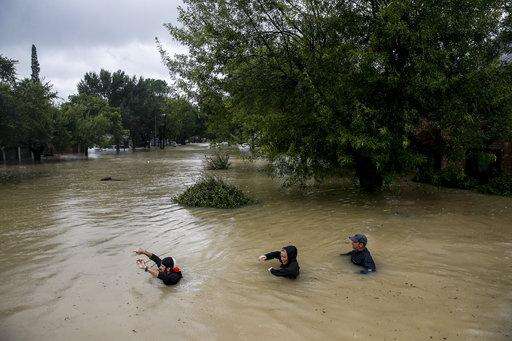
FILE - People wade through chest deep water down Pine Cliff Drive as Addicks Reservoir nears capacity due to near constant rain from Tropical Storm Harvey, Tuesday, Aug. 29, 2017 in Houston. The push of subdivisions and freeways across what once was hundreds of square miles of flood-absorbing tallgrass prairies was part of the U.S.-leading population growth of Houston and surrounding Harris County. But the go-go-growth placed housing developments across the drainage basin of the two major reservoirs and dams safeguarding downtown Houston. (Michael Ciaglo/Houston Chronicle via AP)
The Associated Press

FILE - Volunteer Elizabeth Hill, 8, plays with evacuee Skyler Smith, 7, at a shelter at St. Thomas Presbyterian Church in west Houston as Tropical Storm Harvey continues to affect the area Tuesday, Aug. 29, 2017. The deluge damaged 156,000 dwellings, according to the flood control district for Harris County, which includes Houston. And the stormâs death toll of 42 ranks it as the mainlandâs seventh deadliest hurricane in 50 years. (Jay Janner/Austin American-Statesman via AP)
The Associated Press
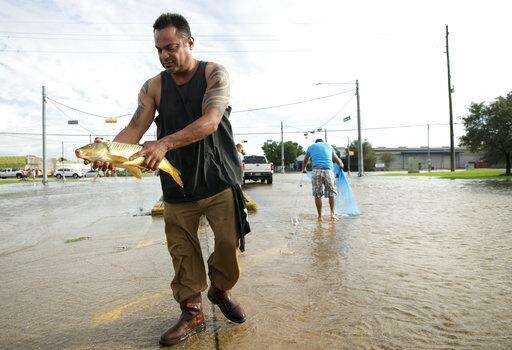
FILE - Javier (no last name given) catches a carp in the middle of Brittmoore Park Drive in west Houston after the Addicks Reservoir overflowed due to days of heavy rain after Hurricane Harvey on Tuesday August 29, 2017. The push of subdivisions and freeways across what once was hundreds of square miles of flood-absorbing tallgrass prairies was part of the U.S.-leading population growth of Houston and surrounding Harris County. But the go-go-growth placed housing developments across the drainage basin of the two major reservoirs and dams safeguarding downtown Houston. (Jay Janner/Austin American-Statesman via AP)
The Associated Press
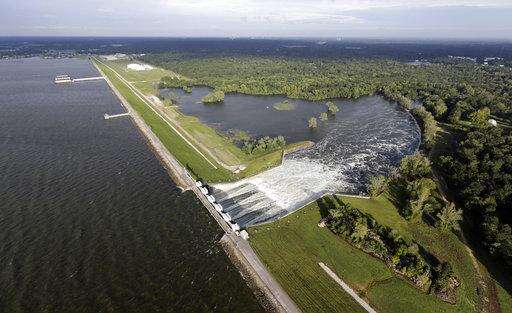
FILE - Water is released from Lake Conroe Tuesday, Aug. 29, 2017, in Conroe, Texas. For more than 130 hours _ from 10 a.m. Friday, Aug. 25, through 10 p.m. Wednesday, Aug. 30 _ Harvey was raining over some part of eastern Texas. When Harvey did move, including a dip back into the Gulf of Mexico for about a day, it was still close enough to pour on Texas. (AP Photo/David J. Phillip)
The Associated Press
FILE - Workers begin repairs to a wall that was lost in the wake of Hurricane Harvey, Wednesday, Aug. 30, 2017, in Rockport, Texas. University of Miami senior hurricane researcher Brian McNoldy said even though coastal cities like Rockport were all but flattened, âUnfortunately, theyâre going to take backstage to Houston.â (AP Photo/Eric Gay)
The Associated Press
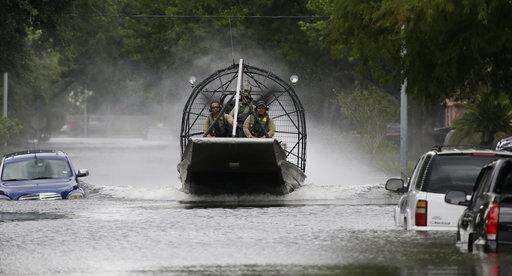
FILE - A U.S. Border Patrol air boat moves through neighborhood inundated by floodwaters from Tropical Storm Harvey in Houston, Texas, Wednesday, Aug. 30, 2017. John Morris, the Border Patrol's chief of staff in South Texas, said the agency had 35 boats in the city's flooded neighborhoods on Thursday, Aug. 31, 2017, and had rescued hundreds. "The agents and the assets that are here in Houston as part of the recovery effort are absolutely 100 percent only here for rescue and safety," Morris said. "There is no enforcement activity being undertaken while we're doing this safety mission." (AP Photo/LM Otero)
The Associated Press
FILE - This combination of satellite images provided by DigitalGlobe shows Simonton, Texas, west of Houston, on Nov. 20, 2016 and Aug. 30, 2017. Hurricane Harvey made landfall at Rockport, Texas on Friday, Aug. 25, 2017. (DigitalGlobe via AP) ©2017 DigitalGlobe
The Associated Press
FILE - Frances Breaux cries as she talks about her fears for two close friends who live near the Arkema Inc. chemical plant Thursday, Aug. 31, 2017, in Crosby, Texas. Breaux said her close friends, an elderly couple that live close to the plant, have not been heard from Thursday. The Houston-area chemical plant that lost power after Harvey engulfed the area in extensive floods was rocked by multiple explosions early Thursday, the plant's operator said. (AP Photo/Gregory Bull)
The Associated Press
FILE - Floodwaters from Tropical Storm Harvey pour over a roadway in Beaumont, Texas, Thursday, Aug. 31, 2017. Usually strong storms blast through an area, dump a foot or so of rain, and move on. But Harvey was stuck between two high pressure weather systems to the east and west that kept pushing it in opposite directions, so it just staggered in a zig-zag pattern across southeast Texas. (AP Photo/Gerald Herbert)
The Associated Press
FILE - A U.S. Army Medivac helicopter crew member, bottom, rescues the third of three persons plucked from the trees around swift water under Interstate 10 at Rose City, Texas, after a problem with their boat, background left, Thursday, Aug. 31, 2017, during flooding in the aftermath of Tropical Storm Harvey. The third officer was wearing a patch reading Florida Fish & Wildlife Conservation Commission on his uniform. (Travis Spradling/The Advocate via AP)
The Associated Press
FILE - Sgt. Destry Riggs scans flooded areas during a search and rescue operation run by the 36th Combat Aviation Brigade of the Texas Army national Guard over areas hit by Tropical Storm Harvey on Friday, Sept. 1, 2017, north of Beaumont, Texas. (Brett Coomer/Houston Chronicle via AP)
The Associated Press
FILE - Jessica Anderson, with her husband Darrell and daughters Lauren, and Harper look at floodwaters in Addicks Reservoir from a closed freeway in the aftermath of Hurricane Harvey Friday, Sept. 1, 2017, in Houston. Usually strong storms blast through an area, dump a foot or so of rain, and move on. But Harvey was stuck between two high pressure weather systems to the east and west that kept pushing it in opposite directions, so it just staggered in a zig-zag pattern across southeast Texas. (AP Photo/Charlie Riedel)
The Associated Press
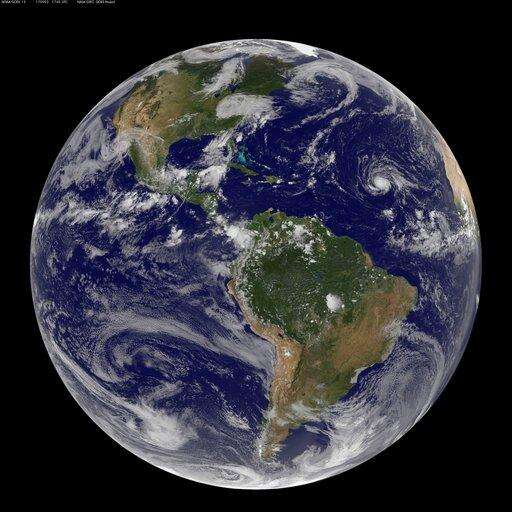
This enhanced satellite image made available by the NOAA GOES Project shows Irma, in the middle of the Atlantic Ocean on Saturday, Sept. 2, 2017 at 1:45 p.m. In the wake of Harvey, meteorologists are already looking warily at another system: Hurricane Irma, which intensified from a tropical storm to a major hurricane in just 30 hours, is steadily moving west across the Atlantic. Itâs still several days away from the nearest land just south of Puerto Rico. (NASA/NOAA via AP)
The Associated Press